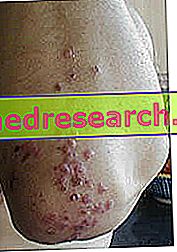What is herpetiform dermatitis
Herpetiform dermatitis (or Duhring's dermatitis, or Brocq's polymorphic painful dermatitis) is a particular dermatological pathology that occurs in individuals with celiac disease. For this reason, this particular type of skin disease is also referred to as skin celiac disease .

See other Photos Dermatitis Herpetiformis
As we know, celiac disease is a permanent intolerance to gluten, an ambiguous and equivocal autoimmune disease, which manifests itself in various ways, leading to consequences such as abdominal swelling, colitis, flatulence, osteoporosis and oral aphthosis.
Erroneously, we tend to consider dermatitis herpetiformis an autoimmune disease; considering, however, the correlation ascertained with celiac disease, Duhring's dermatitis is more correctly classified as a cutaneous manifestation of food intolerance.
In addition, even the name "herpetiform" can be misleading: in fact, at first glance, one might think that this form of dermatitis has a certain connection with the infections triggered by Herpes simplex . In reality there is no etiopathological correlation with Herpes : the term herpetiformis has in fact been attributed to the particular manifestations of this dermatitis, with the appearance of particular blisters, bubbles and crusts, which recall the typical signs left by the aforementioned virus.
The words "of Duhring", on the other hand, are due to the doctor who identified and described the disease, for the first time, in 1884. Later, in 1988, the disease in question was clinically described also by Brocq (hence the name of "painful polymorphic dermatitis of Brocq").
However, to identify the close relationship between this disease and the celiac manifestation, it was necessary to wait until 1966.
Incidence
Fortunately, Duhring's dermatitis is one of the rare diseases, with an incidence of one person per 10, 000; Ireland is an exception, since the pathology is recorded with a frequency of 1: 500.
Herpetiform dermatitis occurs in young people and adults and it is very rare that dermatitis herpetiformis affects infants and the elderly.
It is particularly common in celiac Caucasian individuals in Northern Europe; while it is rare that it affects people of Asian or black race.
Although rare in infants, dermatitis herpetiformis may show its first symptoms in adolescence, with a higher incidence in female individuals. In contrast, in adulthood, male individuals are the most affected.
The statistics also relate dermatitis herpetiformis with celiac disease: the skin disorder occurs every five subjects suffering from celiac disease. In fact, not necessarily all celiac individuals also suffer from this skin disease. On the contrary, an individual with Duhring dermatitis will surely suffer from celiac disease.
Causes
Duhring's dermatitis is classified as an autoimmune bullous dermatosis, despite the inclusion in this category is questioned by experts: as we have seen, in fact, herpetiform dermatitis is closely related to celiac disease. In this regard, dermatitis can be considered the cutaneous effect of a food gluten intolerance: gluten is precisely the cause of the abnormal antibody response (IgA - type A immunoglobulin) responsible for dermal manifestation.
On the other hand, it is also true that the herpetiform manifestation is often associated with other auto-immune pathologies (pernicious anemia, type 1 diabetes or disorders affecting the thyroid).
The genetic footprint and predisposition, in any case, always play a role of primary importance in the etiopathogenesis of herpetiform dermatitis: both this dermal manifestation and celiac disease, therefore, demonstrate the same genetic sensitivity (the genes involved are the same) and, in both diseases, gluten is responsible for the autoimmune reaction.
Immune reactions are controlled by the antigen identification system called HLA ( Human Leukocyte Antigen ), which is fundamental for the proper functioning of defense systems: when the genes that control this system are altered, the probability that the subject is affected by one or by both pathologies are very high; celiacs, in particular, generally possess a specific HLA gene.
To better understand: as a result of a genetic predisposition and of its interaction with other unknown factors, both in the Duhring herpetiform manifestation and in celiac disease, there is a lack of recognition of some of the body's own structures by the immune system. In dermatitis herpetiformis the antibodies attack the skin causing damage to the level of keratinocytes (skin cells), while in celiac disease the attack occurs in the intestinal mucosa.
Symptoms
Duhring's dermatitis manifests itself at cutaneous level with the appearance of itchy eruptions and evident erythematous spots, accompanied by irritation and inflammation: the course is certainly not natural, since the immune system itself generates the reaction.
Generally, the appearance of rashes is preceded by sensations of strong itching or burning that often occur at the level of the elbows, knees, lower back and even at the level of the scalp.
Dermatitis can progress and manifest small blisters and blisters: however, the damage to the skin level does not remain unnoticed, since the subject is continually subjected to a ferocious and unbearable itching, so as not to be able to resist the urge to scratch and rub continuously the interested party. By doing so, skin irritation exponentially worsens, blisters and blisters burst with the consequent formation of scabs, ulcers, erosions and scars. In some cases, even small bleeding can occur.
The rash progresses slowly but inexorably: at first appear small blisters scattered in precise areas of the body, which then evolve into more serious forms, sometimes involving the entire body surface; the sites most affected by herpetiform dermatitis are the legs, arms and back, although there is no lack of possible rashes on the face and scalp.
When the crusts disappear, the scars remain: at these points, the skin may undergo chromatic variations (hypo-pigmentation or, more rarely, hyper-pigmentation) compared to the uninjured skin.
In rare cases, the disease could regress until it finally disappears.
In most cases, moreover, individuals suffering from dermatitis herpetiformis also show intestinal symptoms, such as diarrhea and abdominal pain that tend to increase with the ingestion of foods containing gluten, precisely because of the direct correlation with celiac disease.
Diagnosis
The diagnosis of dermatitis herpetiformis is quite complicated, since it is often confused with other skin disorders, such as Herpes zoster infections (a condition known as " fire of Saint Anthony ") or eczema. The patient should immediately contact a specialist, who will have to perform a biopsy (an invasive test that involves taking and analyzing part of the tissue), associated with the search for antibodies that have triggered the problem, in order to shed light on the origin of the disease. A small part of undamaged skin tissue is taken and analyzed: if the analysis is positive in the presence of specific IgA, then the patient is probably considered to be suffering from Duhring's dermatitis.
IgA are antibodies that belong to the immune system: at intestinal level, type A immunoglobulins are essential for protection against attacks by pathogenic microorganisms; if IgA binds to particular skin tissues, dermatitis can be triggered, as the cells of the immune system rebel against the body itself.
A further diagnosis is carried out by blood tests: the antibodies responsible for gluten intolerance are also sought in the blood. Among the antibodies that can be identified are: antiendomysium, anti-gliadin, and tissue antitransglutaminase antibodies.
Celiacs manifest atrophy of the intestinal villi, associated with folic acid and iron deficiency: the same conditions are found in subjects suffering from dermatitis herpetiformis, therefore it is appropriate to look for possible deficiencies of these substances for the deep diagnosis of dermatitis.
The assessment of the disease is absolutely essential: if a precise diagnosis has not been carried out it is not possible to proceed with a definitive therapy.
Treatments and Treatments
As with many diseases afflicting humans, the best treatment currently available to combat dermatitis herpetiformis is prevention.
More precisely, in the specific case of Duhring dermatitis, prevention must be carried out by adopting a particular diet, which can be associated with a possible pharmacological treatment to alleviate the typical symptoms of the disease.
Diet for herpetiform dermatitis
As just mentioned, in order to prevent the onset of skin manifestations of dermatitis herpetiformis - but also of the same celiac disease - it is very important to adopt a very specific diet, which must be totally free of gluten-containing foods.
A gluten-free diet is, in fact, the only possible treatment, capable of completely eradicating the triggering factors. If this is not sufficient, following the doctor's advice, it is possible to use specific drugs.
Pharmacological treatment
If the gluten-free diet is not sufficient to prevent the occurrence of dermatitis herpetiformis, the doctor may prescribe the patient to take some drugs in order to fight the symptoms of the disease.
In this regard, the active ingredients usually used are dapsone (preferential therapy) and sulfapiridine (a less effective alternative treatment compared to the previous one).
Generally, these drugs act quite rapidly, so that - in most cases - the symptoms resolve after a few days of treatment.
These powerful drugs, however, can lead to secondary side effects such as vomiting, anemia and lack of appetite. Furthermore, they act only in the cutaneous manifestation, without any effect on the intestinal level (they are not suitable for combating celiac disease).
To conclude, therefore, only a scrupulous gluten-free diet is the most appropriate solution to counter the onset of herpetiform dermatitis.



